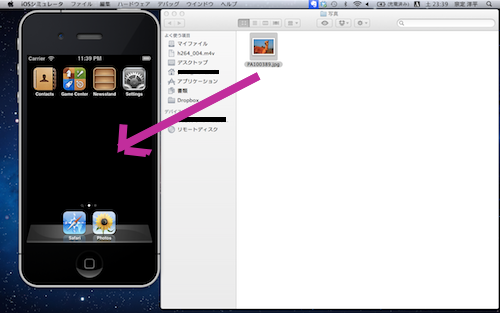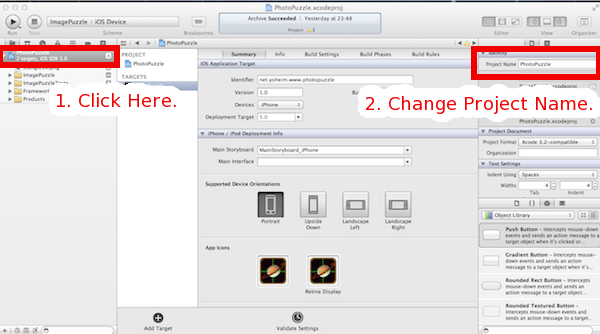[XCODE] iPhoneアプリでデバイスの回転を独自に対応する
こんにちは、@yoheiMuneです。
今日は、iPhone/iPadアプリケーションで、デバイスの回転に独自に対応する方法を学んだので、ブログに残しておきたいと思います。

まずはデバイスの回転を感知して、必要に応じて各種アイテムを回転させる
デバイス回転を独自に感知するには、UIDeviceクラスとNSNotificationCenterクラスを利用します。 詳しい利用方法は、”iPhoneの向きを特定するもう一つの方法@YoheiM.NET”を参考にしてみて下さい。
デバイスが回転したら、特定のメソッドが呼び出されるように設定します。
// ViewControllerの実装にて - (void)viewDidLoad { [super viewDidLoad]; // デバイスの回転を開始する [[UIDevice currentDevice] beginGeneratingDeviceOrientationNotifications]; // デバイスが回転した際に、呼び出してほしいメソッドを設定する。 // 今回は、selfのdidRotate:というメソッドを呼び出し対象に設定してみました。 [[NSNotificationCenter defaultCenter] addObserver:self selector:@selector(didRotate:) name:UIDeviceOrientationDidChangeNotification object:nil]; }
デバイスが回転したら、以下のメソッドが呼び出されます。
このメソッドの中で、デバイスの向きに合わせて画面上のアイテムを回転します。
また、ステータスバーの位置も修正します。
// デバイスが回転した際に、呼び出されるメソッド - (void) didRotate:(NSNotification *)notification { UIDeviceOrientation o = [[notification object] orientation]; // 縦向きで、ホームボタンが下になる向き if (o == UIDeviceOrientationPortrait) { // 画面上の各種アイテムを回転させる為に作ったメソッド。内容は下を参照ください。 [self correspondToDeviceRotation:0]; // ステータスバーの位置を変更する。 [[UIApplication sharedApplication] setStatusBarOrientation:UIDeviceOrientationPortrait animated:YES]; // 縦向きで、ホームボタンが上になる向き } else if (o == UIDeviceOrientationPortraitUpsideDown) { [self correspondToDeviceRotation:180]; [[UIApplication sharedApplication] setStatusBarOrientation:UIDeviceOrientationPortraitUpsideDown animated:YES]; // 横向きで、ホームボタンが右になる向き } else if (o == UIDeviceOrientationLandscapeLeft) { [self correspondToDeviceRotation:90]; [[UIApplication sharedApplication] setStatusBarOrientation:UIDeviceOrientationLandscapeLeft animated:YES]; // 横向きで、ホームボタンが左になる向き } else if (o == UIDeviceOrientationLandscapeRight) { [self correspondToDeviceRotation:270]; [[UIApplication sharedApplication] setStatusBarOrientation:UIDeviceOrientationLandscapeRight animated:YES]; // 画面が上向き } else if (o == UIDeviceOrientationFaceUp) { NSLog(@"device orientation is Face Up."); // no need actions. // 画面が下向き } else if (o == UIDeviceOrientationFaceDown) { NSLog(@"device orientation is Face Down."); // no need actions. // 向きが不明な場合 } else { NSLog(@"device orientation is Unkown."); // no need actions. } } // 画面上の各種アイテムを回転させるメソッド - (void) correspondToDeviceRotation : (int)angle { // 回転させるためのアフィン変形を作成する CGAffineTransform t = CGAffineTransformMakeRotation(angle * M_PI / 180); // 回転させるのにアニメーションをかけてみた [UIView beginAnimations:@"device rotation" context:nil]; [UIView setAnimationDuration:0.3]; trustButton.transform= t; // ゴミ箱ボタン undoButton.transform= t; // Redoボタン redoButton.transform= t; // Undoボタン // アニメーション開始 [UIView commitAnimations]; }
ここでは、デバイスの向きに合わせて、アフィン変換を利用して、 ボタンの回転を行っています。アフィン変換の回転については、 ”ローテーションジェスチャーを簡単に実装する@YoheiM.NET”を 参考にして頂けると幸いです。
独自にデバイスの回転に対応する上で大切なこと
それは、ステータスバーの位置を、デバイスの向きによってちゃんと変える事です。
これを行う事で、新しく開くView(例:UIImagePickerView)などの向きを変えることが出来ます。
動作させたところ、ステータスバーが上になるようにUIViewの向きが決定されるようです。
という事で、ステータスバーの位置変更も忘れず行うと、デバイスの回転に自分で対応することは、出来るようです。
最後に
デバイス回転を、「shouldAutorotateToInterfaceOrientation:」メソッドを使わずに行う方法には、かなり悩まされました。
でも、いったんの上記のような解決策を作れて良かったヨカッタ♪(´ε` )
iPhoneアプリ作成では、学ぶ事がホントに多いですね。もっと実力をつけねば。








